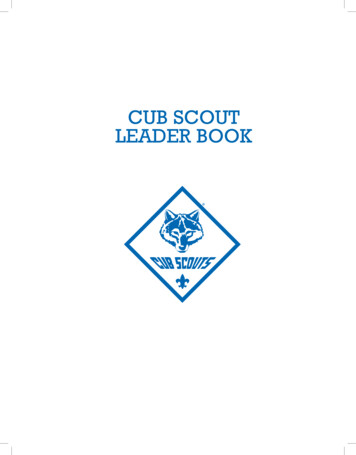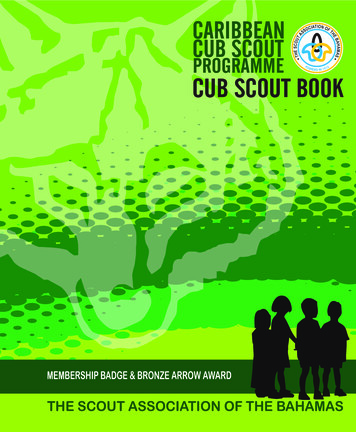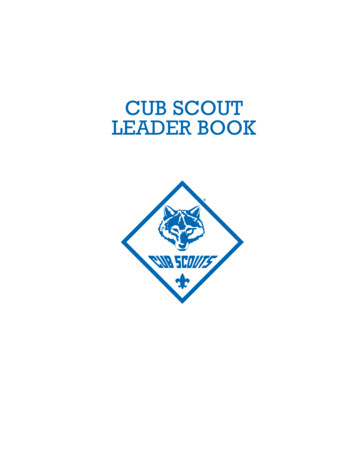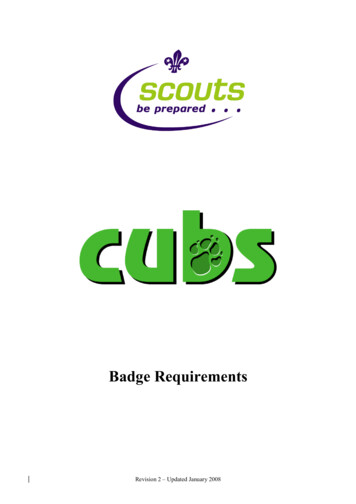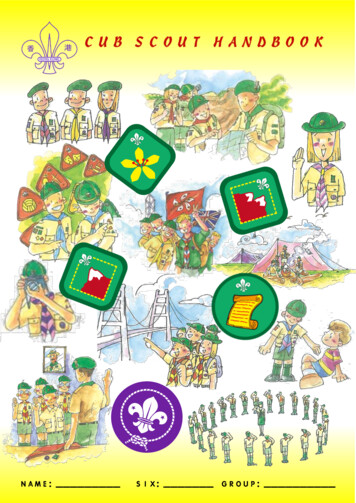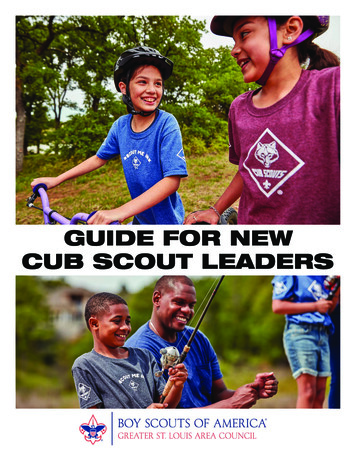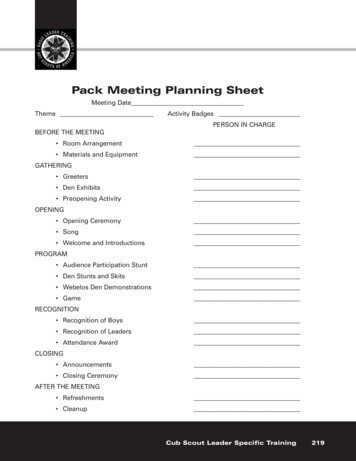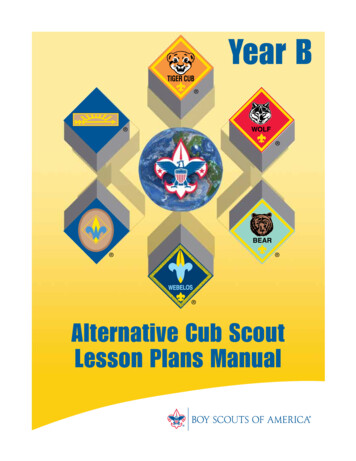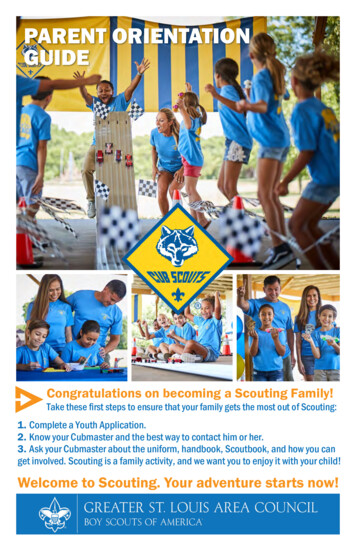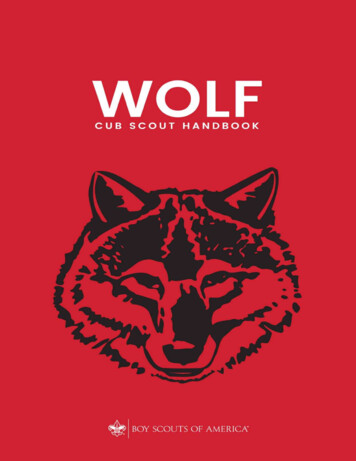
Transcription
DEAR PARENTWelcome to SCOUTING! We are so pleased that you have decided to joinour movement, and we look forward to working together with your family toraise leaders of character who will shape our future in a positive way.Through Scouting, youth can develop strong connections and make importantcontributions to their families, their community, and society at large. Wewould like to congratulate you for choosing a program with the keyingredients for helping youth grow into competent, caring, and confidentadults. Research about highly effective programs has shown that theseingredients are: Positive and sustained adult-youth relationships Youth activities that build life skills Youth participation in and leadership of valued community activitiesThe Scouting program significantly enhances opportunities for personaldevelopment, including higher grades, school engagement, self-esteem, andresilience. The program provides a safe environment where relationships are
built with caring and competent adults, where youth are encouraged to takeleadership of their development, and where useful life skills are acquired.The programs of the BSA focus on developing leaders of character. We dothis by presenting and reinforcing the values found in the Scout Oath andScout Law. It is enormously important for our members to have a moralcompass and a strong work ethic to go along with it. For more information onthe benefits of Scouting, go to www.scouting.org/programs/.To realize the potential of Scouting, it is critical that we take all possiblesteps to create and maintain a safe environment for all who participate. Thatinvolves understanding personal boundaries and knowing what appropriatebehaviors are in Scouting. Research indicates one of the best deterrentsagainst child abuse is an open and continuous conversation between parentsand their children. The following information is offered to help your familyestablish and maintain a safe environment where you can prevent your childor another child from being abused. This information can also empower youto stop abuse as soon as possible and seek the necessary help. The Committeefor Children recommends having the Hot Chocolate Talk to begin theconversation. (See “National Resources.”)Child abuse is something we would rather not talk about, or even think about,but we must. Many of us find it challenging and difficult to begin thisconversation with our children, and the risk is that we might never get aroundto it. There are numerous factors that can lead to abuse. Together, you andyour program leader must work together to ensure all Youth Protection andHealth and Safety policies are understood and followed. For additionalinformation, see “Additional BSA Resources” on page 26. Your child is thatimportant. In fact, all of our children are that important. Youth ProtectionBegins With YOU.The information you will read is not meant to scare you. It is meant to raiseyour awareness about many forms of abuse and how to recognize it andreport it. It is part of the BSA’s commitment to creating safe environmentsfor all youth. The Centers for Disease Control, the Vision for ViolencePrevention, and youth-serving medical facilities committed to preventingchild maltreatment refer to child abuse as a public health epidemic. The BSAand other youth-serving organizations are committed to investing resourcesand engaging their top experts to end all forms of child abuse and
maltreatment.Using This BookletThis booklet can’t address all threats to personal safety for our children inand out of Scouting, but it will inform and empower you to better recognize,respond to, and report most forms of abuse and begin the conversation. Thefirst section contains information for parents about child abuse and some tipsfor talking with your child about child abuse. In the second section, we putthat knowledge to work with exercises for you to share with your child.Research shows that children whose parents talk to them about preventingabuse are better able to protect themselves and are more likely to tell if theyare experiencing abuse or have been abused.This conversation is the start of a dialogue between you and your child aboutpersonal safety awareness. As your child grows, look for opportunities tostrengthen open communication and give them the reassurance that no matterhow frightening something may be, you and other trusted adults are there tohelp.WHAT EVERY PARENT SHOULD KNOWBefore we can understand what to do about abuse, we must understand whatwe mean by abuse. Children can experience abuse in many ways: neglect,physical abuse, sexual abuse, or emotional abuse. Often a child who is abusedin one way is abused in multiple ways. When we protect a child from oneform of abuse, such as neglect, we are often protecting the child fromadditional forms of abuse.Abuse often occurs in the home by parents, stepparents, siblings, and otheryouth and/or caretakers. It also occurs in schools, churches, and youthserving organizations. Regardless of what you have heard, there is no knownprofile of an abuser or child molester. However, there are behaviors thatchildren exhibit that may be an indicator that the child is being abused. Abusecan occur despite our screening process, which includes criminal backgroundchecks, reference checks, and checks against the Volunteer ScreeningDatabase. For more information on the BSA’s screening protocol, see theGuide to Safe Scouting, found at www.scouting.org.
The overall safety of your child is important to us. If you have any concernsabout the safety of your child or the actions of leaders or parents, contactyour local council Scout executive immediately.In an emergency, when you are unable to reach the Scout executive, the BSAprovides a 24-hour helpline: 1-844-SCOUTS1 (1-844-726-8871).The Scouts First Helpline is a resource for incidents involving child abuse orserious risk of harm to children only. It is not for general information orquestions.For questions about training, policy interpretation, program, etc., pleasecontact your Scout executive or Member Care at 972-580-2489.Sexual AbuseWhen an adult or older youth uses his or her authority to involve a child inany type of sexual activity, it is child sexual abuse. Sexual abuse is unwantedsexual activity, with persons using force, making threats, or taking advantageof victims not able to give consent. Another type of sexual abuse occurswhen an adult or youth crosses clear boundaries in communications, orexposes the youth to alcohol, drugs, or pornography. Children can be at riskof sexual abuse anywhere there is access or opportunity, such as at home; at aneighbor’s house; at school, field trips, and public events; and even inScouting.A common misconception about sexual abuse is that children are most likelyto be abused by strangers. In fact, the abuser is usually someone the childknows and trusts, and most likely is known to you, the parent. These adults oryouth are most often male, but females also can be offenders.Sexual Abuse by AdultsAdults who abuse children may manipulate, bribe, coerce, threaten, or force achild into feeling like a partner in the sexual activity. They most often use amultistep “grooming” process that focuses on the child’s needs and possiblyon the child’s parents as well. Adults who may sexually harm your childmight offer free babysitting services or overnight trips, for example, or makefriends with you to gain enough trust to be alone with the child.
Once the potential abuser has identified the target child, characteristically, thegrooming process moves to what looks like harmless touching—such ashugging and massages—or exposure, and looking for chances to be alonewith the child. The person usually seeks a child who craves affection orattention and makes that child feel special by spending a lot of time withthem and giving gifts and money. All children are vulnerable to sexual abusebecause of their innocence, naivete, and total trust in and dependence uponadults.A red flag is a leader who violates the BSA’s Youth Protection policy of noone-on-one contact in Scouting and seeks one-on-one contact with youth,especially outside of the Scouting program and utilizing digital and socialmedia for such contact.When the individual senses that the child has become comfortable withphysical contact and has an emotional bond, the physical contact becomesmore intense. The individual may prey on the child’s natural curiosity aboutsexuality and may say that they are helping or teaching them sex education.The individual may suggest playing inappropriate games. The grooming mayinvolve violating rules, drinking alcohol, smoking cigarettes—all to create a“special relationship.”Most children don’t know they are being groomed until it is too late.Many abusers are clever enough to trick the victim into believing that theyare equally to blame or will not be believed if they tell. Other abusers willmanipulate the emotional bond and threaten to withhold love and attention ifthe child tells anyone. Many children feel trapped, overwhelmed, or ashamedand are afraid to tell.Some children find it difficult to immediately report or disclose the abusebecause of fear or love of the individual abusing them.Sexual Abuse by Other YouthIt is also possible for a child of similar age or older to abuse another throughforce, position of authority, or manipulation. About a third of sexual abuseoccurs at the hands of other children, including siblings, relatives, older
youth, and youth in positions of authority and supervision who manipulatethrough bullying behavior using their size or authority. Overnight activitiespose a greater risk of abuse including sleepovers, campouts, etc. Any peeractivity, such as a club initiation or hazing, in which sexual activity isincluded, is a form of sexual abuse and should be addressed and reportedimmediately.Adults who learn or discover that youth-on-youth abuse has occurred or whohave concerns about youth exhibiting questionable, problematic, or illegalsexual behaviors must take immediate steps to stop it and report. Refer towww.ncsby.org as a resource for additional information.Responding/ReportingIf you suspect a child has experienced sexual abuse or has sexually abusedother children inside or outside of Scouting, call 911 immediately and make areport as required by your state and child protective services, or CPS.Additional reporting may be required by your state.Additionally, contact your local council Scout executive. If the Scoutexecutive is unavailable, contact the Scouts First Helpline at 1-844SCOUTS1 (1-844-726-8871).Physical AbusePhysical abuse is the deliberate injury of a child by a person responsible forthe child’s care.Physical abuse injuries can include bruises, broken bones, burns, and scrapes.Children experience minor injuries as a normal part of childhood, usually inplaces such as the shins, knees, and elbows. When injuries do not seem to bethe typical “bumps and bruises” of childhood or do not match the explanationgiven, it is possible that the child is being or has been abused.Blows to the stomach may result in abdominal bruises, even if you can’t see amark. When a child complains of pain or says that they have been punched inthe stomach, this should be taken seriously, because there may be internalinjury.The following signs are commonly associated with abuse but are notabsolutes:
Explanations of an injury, provided to you by a child or parent, that don’tmake sense Injuries on a child who has been absent from school or youth activities Complaints of soreness when moving Fear of going home with or to parentsNeglectNeglect often involves depriving a child of food, clothing, shelter, medicalcare, or other necessities of life. Neglect can also involve exposing a child toharmful substances or materials, such as drugs, alcohol, or pornography, or toharmful practices such as violent behavior.A number of clues suggest that a child might be neglected. The child whofrequently comes to meetings with body odor, the child who is frequentlyunkempt, the child who is living in a dangerous environment, and the childwith an obvious medical need that goes unattended all are showing signs thatthey could be neglected. So is the child who is always hungry or who hoardsor steals food, the child who is seldom dressed appropriately for the weather,and the child who regularly talks of seeing a parent drunk or bruised frombeing hit.Any time a child shows a need or condition that a reasonable parent wouldattend to—especially when failure to provide for the need harms the child’sphysical or emotional well-being— the child is likely being neglected.Emotional AbuseA child suffers from emotional abuse when continually ridiculed, blamed,humiliated, or compared unfavorably with others.Emotional abuse damages the child’s self-esteem. Studies find that emotionalabuse is just as harmful as, if not more harmful than, other forms of abuse. Itcan lead to developmental problems, speech delays, depression, anxiety, andconditions such as low empathy and difficulty with friends.Emotional abuse can occur when a parent completely ignores, rejects, orregularly threatens to beat a child, or when a child struggles to meet aparent’s unreasonable expectations in academics, athletics, or other areas.
Emotional abuse can also result if an adult or older youth provides a childwith alcohol, drugs, pornography, or other harmful substances or materials.Spiritual AbuseAn often-overlooked form of child maltreatment is spiritual abuse— theincorporation of religion into the abuse of a child. Some studies suggest thatadults who abuse children are particularly attracted to faith communitiesbecause they find clergy and other faith leaders to be very trusting. If yourchild is active in a faith community, make sure to ask about what youthprotection policies they have in place.Youth With Developmental Disabilities/Special NeedsChildren with disabilities or behavioral problems are at greater risk of abusethan other children. Adults who abuse children believe that youth withdisabilities will be least likely to report the abuse. Accordingly, while it isimportant to teach all children to recognize would-be abusers and to tell atrusted adult about abuse, this message is particularly important for childrenwith disabilities.Special ConsiderationsIt is vital that parents be forthcoming with unit leaders about any concerns orexpectations you have about your child, as well as medication that mayinfluence behavior.Signs Your Child Might Have Been AbusedThe clearest sign of abuse is that your child tells you that someone hurt orscared them or made them feel uncomfortable or you uncover evidence ofabuse. Unfortunately, many children never speak of abuse, so it is importantfor you to maintain communications where your child can openly discussmatters of personal safety. Remember, reassuring them that they can tell youanything needs to be a continuous message you deliver.If your child has been abused by a parent, relative, sibling, Scout, Scoutleader, or someone else close to you, it may be particularly difficult for thechild to disclose the abuse to you and also difficult for you to accept. Studies
show that children rarely lie about sexual abuse or other maltreatment. So ifyour child tells you that they have been abused, or if your child is especiallyuncomfortable with a particular person or situation, always take the behavioras your sign to act. Remember, children communicate with us through theirwords, actions, and feelings. Communication about abuse is often subtle andindirect. A child may not come right out and say something; instead they maysay, “I have a friend who .,” to see how an adult will react. The child whoreceives a helpful, thoughtful, and sympathetic response is more likely toreveal that they are not actually talking about their friend and tell you aboutabuse experiences. Listen carefully.Each child’s response to abuse is unique. Signs of stress frequentlyaccompany abuse, but stress can have many causes. Other possible indicatorsof abuse include Sudden withdrawal from activities the child previously enjoyed Reluctance to be around or, especially, alone with a particular individual,adult or youth Changes in behavior or in school performance, including lower grades Inability to focus or learning problems with no known cause Hypervigilance (excessive watchfulness as if anticipating something badhappening) Overly compliant behavior or an excessive desire to please In addition, achild currently being sexually abused may Have difficulty sitting or walking Complain of pain or itching in the genital or anal areas Use sexually explicit language or act out sexual behavior inappropriate fortheir age For more information, take the BSA’s Youth Protection Trainingat https://my.scouting.org.Responding/ReportingIt is OK to ask a child about suspicious injuries or behaviors. In fact, youshould. If the child tells of abuse or gives an answer that doesn’t make senseand you feel the child is in danger, you should immediately contact the locallaw enforcement agency or state department of children and family services.You also need to contact your local council Scout executive. If your local
council Scout executive is not available, contact the Scouts First Helpline at1-844-SCOUTS1 (1-844-726-8871).Scouts First HelplineAs part of its “Scouts First” approach to the protection and safety of youth,the BSA has established a dedicated 24-hour helpline to receive reports ofknown or suspected abuse or behavior that puts a youth at immediate risk.In an emergency, when you are unable to reach the Scout executive, the BSAprovides a 24-hour helpline: 1-844-SCOUTS1 (1-844-726-8871).The Scouts First Helpline is a resource for incidents involving child abuse orserious risk of harm to children only. It is not for general information orquestions.For questions about training, policy interpretation, program, etc., pleasecontact your Scout executive or Member Care at 972-580-2489.1-844-SCOUTS1 (1-844-726-8871)When to use it: Anytime you believe a youth has been harmed or their safety and wellbeing is at risk, and you cannot immediately reach your local councilScout executive or local council. If a Scout is bullied because of race, color, national origin, religion, sexualorientation, or disability, and local efforts are unable to resolve theproblem.If someone is at immediate risk of harm, always call 911.For more information about reporting requirements, call 911 or see the ChildWelfare Information Gateway website at www.childwelfare.gov for yourstate hotline number.Bullying/CyberbullyingBullying is any intentional, aggressive behavior, often involving animbalance of power or strength, that usually is repeated over a period of time.Bullying can take many forms, including hitting or punching, teasing or namecalling, intimidating use of gestures or social exclusion, or sending insulting
messages by phone or computer (cyberbullying). If your child is beingtargeted, do not blame your child or tell them to ignore the behavior orengage in physical retaliation. Instead, listen carefully and report the bullyingbehavior to the people responsible for the program where bullying isoccurring. For more information, please see the BSA’s Bullying Awarenesswebpage at g orwww.stopbullying.gov.Victims of bullying behavior are more likely to be depressed, have low selfesteem, be absent from school or other activities, feel sick, or think aboutdeath by suicide.Any information indicating a youth has mentioned or talked about suicidemust be taken seriously and reported to the Scout executive so appropriateactions may be taken. If unable to reach the Scout executive, contact theScouts First Helpline at 1-844-SCOUTS1 (1-844-726-8871).Internet/Social Media SafetyToday’s youth are spending more time than ever using digital media foreducation, research, socializing, and fun. Unfortunately, abusers know thistoo. Parents play an important role in keeping children safe from those whouse the internet and social media to access and harm children. Parents canlimit the danger by setting basic guidelines such as when children go online,
what sites they can visit, and having regular check-ins to see and discuss thechoices that are being made with technology. To help families and volunteerskeep youth safe while online, the BSA introduced the Cyber Chip.In developing this tool, the BSA teamed up with content expert NetSmartz ,part of the National Center for Missing and Exploited Children and trainingexpert for many law enforcement agencies. Earning the Cyber Chip is arequirement for all Cub Scout ranks except Bobcat. For more information,please see the BSA’s Cyber Chip webpage -chip and NCMEC’sNetsmartz website at www.netsmartz.org. The NCMEC’s CyberTiplinenumber is 800-843-5678.The BSA’s Barriers to AbuseOur goal in the BSA is to create and maintain a safe environment so that allcan benefit from the program. The greatest positive step that we can taketogether is to put us all in a position to succeed by having rules that we allagree to follow. You should expect your child’s Cub Scout pack to follow theYouth Protection policies put in place by the BSA to provide additionalsafety for your child and all who are involved in Scouting. These policies arehelpful for anyone who works with or spends time with children who are nottheirs, and not just in Scouting. They are practices used by teachers, doctors,camp counselors, coaches, and other adults who professionally work withchildren. Youth Protection policies and Health and Safety procedurescontinue to be updated regularly. For the most up-to-date information andchanges or additions to policies and procedures, go towww.scouting.org/health-and-safety/gss.You should discuss these policies with your child so that you, your child, andleaders have a shared understanding of what is expected in Scouting.Leader Registration RequirementsThe chartered organization representative, or in their absence the executiveofficer of the chartered organization, must approve the registration of theunit’s adult leaders.Registration includes:
Completion of application including criminal background check andmandatory Youth Protection training Volunteer Screening Database checkYouth Protection training is required for leaders when renewing theirregistration or at unit charter renewal.Adult program participants must register as adults and follow YouthProtection policies. Up-to-date Youth Protection and Health and Safetyinformation is available at www.scouting.org/health-and-safety/gss.Adult SupervisionTwo registered adult leaders 21 years of age or over are required at allScouting activities, including meetings. There must be a registered femaleadult leader 21 years of age or over in every unit serving females. Aregistered female adult leader 21 years of age or over must be present for anyactivity involving female youth. Notwithstanding the minimum leaderrequirements, age- and program-appropriate supervision must always beprovided.All adults accompanying a Scouting unit who are present at the activity for72 total hours or more must be registered as leaders. The 72 hours need notbe consecutive.One-on-one contact between adult leaders and youth members is prohibitedboth inside and outside of Scouting. In situations requiring a personal conference, the meeting is to beconducted with the knowledge and in view of other adults and/or youth. Private online communications (texting, phone calls, chat, IM, etc.) mustinclude another registered leader or parent. Communication by way of social media (Facebook, Snapchat, etc.) mustinclude another registered leader or parent.Discipline must be constructive. Discipline must reflect Scouting’s values. Corporal punishment is never permitted. Disciplinary activities involving isolation, humiliation, or ridicule are also
prohibited.ResponsibilityLeaders must ensure that all participating in Scouting activities abide by theScout Oath and Scout Law.Adult leaders and youth members share the responsibility for the safety of allparticipants in the program, including adherence to Youth Protection andHealth and Safety policies. Adult leaders are responsible for monitoring behavior and interveningwhen necessary. Physical violence, sexual activity, emotional abuse, spiritual abuse,unauthorized weapons, hazing, discrimination, harassment, initiation rites,bullying, cyberbullying, theft, verbal insults, drugs, alcohol, andpornography have no place in the Scouting program and may result inrevocation of registration.All leaders are required to adhere to the Scouter Code of Conduct located inthe Guide to Safe Scouting: onsSeparate accommodations for adult males and females and youth males andfemales are required.
Tenting Separate tenting arrangements must be provided for male and femaleadults as well as for male and female youth. Youth sharing tents must be no more than two years apart in age. In Cub Scouting, parents and guardians may share a tent with their family. In all other programs, youth and adults tent separately. Spouses may share tents.Lodging/Cabin AccommodationsWhenever possible, separate cabins or lodging should be provided for maleand female adults as well as for male and female youth. Where separateaccommodations cannot be provided due to group size or limited availability,modifications may be made. Where completely separate accommodations arenot available, additional supervision is required. If adults and youth of the same gender occupy single-roomaccommodations, there must be a minimum of two adults and four youth,with all adults being Youth Protection trained. Physical separation by other means, including temporary barriers or space,should be used only when no other arrangements are possible. These modifications are limited to single-gender accommodations.RestroomsSeparate shower and latrine facilities should be provided for male and femaleadults as well as for male and female youth. If separate facilities are notavailable, separate times should be scheduled and posted.Privacy of youth is respected. Adults and youth must respect each other’s privacy, especially insituations such as changing clothes and taking showers at camp. Adult leaders should closely monitor these areas but only enter as neededfor youth protection or health and safety reasons.Program Requirements
The buddy system should be used.The use of smartphones, cameras, mirrors, drones, etc., in places or situationswhere privacy is expected is prohibited.All aspects of the Scouting program are open to observation by parents andleaders.The BSA does not recognize any secret organizations as part of its program.Hazing and initiations are prohibited and have no part during any Scoutingactivity.All forms of bullying and harassment including verbal, physical, andcyberbullying are prohibited.Inappropriate public displays of affection are prohibited.Sexual activity is prohibited.Appropriate attire is required for all activities.Reporting RequirementsAdult leaders and youth members have a responsibility to recognize, respond
to, and report Youth Protection violations and abuse.Mandatory Report of Child AbuseIf you see or suspect a child is being abused, stop the abuse immediately andreport it. All persons involved in BSA programs must report any instance ofchild abuse to local law enforcement and, in some states, also to the state’schild protective services, or CPS. This includes any good-faith suspicion orbelief that a child is or has been physically or sexually abused, physically oremotionally neglected, exposed to any form of violence or threat, or exposedto any form of sexual exploitation including the possession, manufacture, ordistribution of sexually exploitive images, online solicitation, enticement, orshowing of obscene material.This duty cannot be delegated to any other person. After reporting to lawenforcement, the matter must also be reported to the Scout executive soappropriate actions may be taken. If unable to reach the Scout executive,contact the Scouts First Helpline at 1-844-SCOUTS1 (1-844-726-8871).Ensure notification has been made to parents/guardian. Failing to reportsuspected child abuse may be a criminal law violation in your state. It isimportant to note that all states allow immunity from criminal and civilliability for good-faith reporting of suspected abuse, even if it is laterdetermined to be unfounded.Fore more information, please see your state’s reporting statutes on the ChildWelfare Information Gateway website at www.childwelfare.gov.Additional BSA ReportingYouth Protection Policy Violations Serious Youth Protection policy violations or behaviors that put a youth’ssafety at risk must be reported to the local council Scout executive. Alternatively, policy violations may be reported to the Scouts FirstHelpline when the local council Scout executive is not available. Online reporting is also available at Speaking With a Child Who Discloses or Indicates Abuse
When speaking with a child who discloses or indicates abuse, your role is tobecome the trusted adult. A trusted adult is someone with whom a child cantalk freely about their feelings and problems and who provides healthyguidance and support.When informed about abuse, a trusted adult Gets actively involved. Sees something and stops it. Suspects something and reports it.Seek advice from an expert when you are unsure.Adults should recognize that talking with children about abuse, especiallysexual abuse, is not comfortable for anyone; however, a child’s first timetelling someone—and your response—may have lasting effects. If a childreports that the
your local council Scout executive immediately. In an emergency, when you are unable to reach the Scout executive, the BSA provides a 24-hour helpline: 1-844-SCOUTS1 (1-844-726-8871). The Scouts First Helpline is a resource for incidents involving child abuse or serious risk of harm to child
